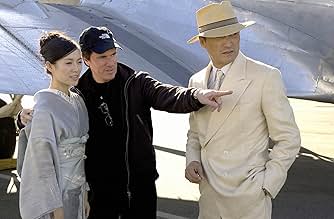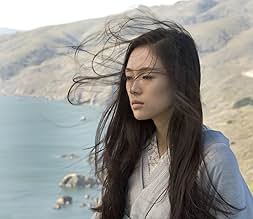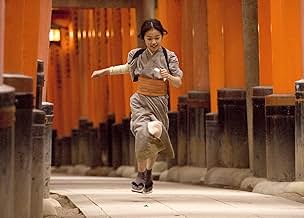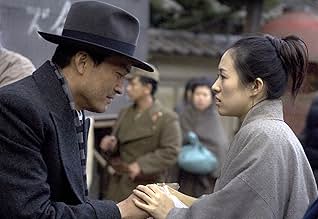Nitta Sayuri révèle comment elle a transcendé ses origines dans un village de pêche pour devenir l'une des geishas les plus célèbres du Japon.Nitta Sayuri révèle comment elle a transcendé ses origines dans un village de pêche pour devenir l'une des geishas les plus célèbres du Japon.Nitta Sayuri révèle comment elle a transcendé ses origines dans un village de pêche pour devenir l'une des geishas les plus célèbres du Japon.
- Réalisation
- Scénario
- Casting principal
- Récompensé par 3 Oscars
- 32 victoires et 47 nominations au total
Avis à la une
Can a group of American men and Chinese actresses render the world of a Japanese geisha? The answer is yes, with stunning beauty
and regrettable flaws.
Truth be told, this movie was not as bad as its trailer led me to expect it to be. It had a story to tell (although it crumbles in the end),images to show, and material to present. There were ample displays of exquisite beauty -- the trailing tails of silk kimonos, the subtle allure of hand gestures, and the captivating scene of kabuki dance theater ...
On the other hand, the American director was not able to pull the Japanese out of Chinese actresses. (This movie was so crowded by famous Chinese idols that I found myself inadvertently searching for Joan Chen among the cast.) To be fair, all three main actors (Gong Li in particular) show strong performances that made me sympathetic to Rob Marshall's choices. However, they remain utterly Chinese throughout this movie. The look and accent are not the only problems. They lacked the kind of extreme femininity and excessive felicity of the delicately mechanical gesture and movements of traditional Japanese ladies you see in custom dramas of Japanese production. (Michelle Yeoh seems to be the only one trying a little bit of those, but it did not quite work for some reason.)
So, let me re-address the question: Can a group of American men and Chinese actresses render the world of a geisha? The answer, I guess, really depends on what you are looking for. If you would like a little bit of delight from an aesthetically pleasing picture with a dubious authenticity and realism, this movie delivers it. I would not say Rob Marshall failed completely. Memoirs of a Geisha is not the first, nor the last, movie that subjects another culture to the crude lens of American exoticism. It definitely is not the worst one.
Truth be told, this movie was not as bad as its trailer led me to expect it to be. It had a story to tell (although it crumbles in the end),images to show, and material to present. There were ample displays of exquisite beauty -- the trailing tails of silk kimonos, the subtle allure of hand gestures, and the captivating scene of kabuki dance theater ...
On the other hand, the American director was not able to pull the Japanese out of Chinese actresses. (This movie was so crowded by famous Chinese idols that I found myself inadvertently searching for Joan Chen among the cast.) To be fair, all three main actors (Gong Li in particular) show strong performances that made me sympathetic to Rob Marshall's choices. However, they remain utterly Chinese throughout this movie. The look and accent are not the only problems. They lacked the kind of extreme femininity and excessive felicity of the delicately mechanical gesture and movements of traditional Japanese ladies you see in custom dramas of Japanese production. (Michelle Yeoh seems to be the only one trying a little bit of those, but it did not quite work for some reason.)
So, let me re-address the question: Can a group of American men and Chinese actresses render the world of a geisha? The answer, I guess, really depends on what you are looking for. If you would like a little bit of delight from an aesthetically pleasing picture with a dubious authenticity and realism, this movie delivers it. I would not say Rob Marshall failed completely. Memoirs of a Geisha is not the first, nor the last, movie that subjects another culture to the crude lens of American exoticism. It definitely is not the worst one.
I lived in Japan for 3 years and I loved the book, rich with visual imagery. I went to the see the movie with a good deal of trepidation, convinced that they were going to butcher it and sex it up to appeal to American audiences. Instead I sat spellbound in my seat as I watched the images that Arthur Golden has created in my mind with words years before, play themselves out on the screen in front of me. Every shot, ever scene, every tiny detail was just beautiful. I literally did not look away from the screen the entire time. The acting wasn't spectacular. I think they could have found somebody better to play Sayuri. The children were all wonderful. The stand-out actress by far was Gong Li as Hatsumomo. The villain had the best opportunities to show her skills as a thespian. The plot stuck very closely to the book. They eliminated the scenes that they needed to in the interest of time, but they didn't try to take any shortcuts or speed up the plot. I really felt like the story was played out beginning to end without sacrificing any of the meat. You'll read a lot of reviews in the coming weeks praising the gorgeous photography. Every word is true. Words like "lush" and "exquisite" only begin to do it justice. I've never had the experience of being transported to another time by a movie in quite this way.
In Japan of the 20's, the nine years old Chyio (Suzuka Ohgo) and her sister Satsu (Samantha Futerman) are sold by her fisherman father to a Geisha house in Miyako. Satsu is not accepted in the house and is sent to a brothel, and along the years, Satsu escapes from he brothel where she lived and the rebel Chyio is left alone, becoming a slave of a geisha. However, six years later, she learns how to become the geisha Sayuri (Ziyi Zhang) with the support of the successful Mameha (Michelle Yeoh), while fighting against the evil and jealousy of the wicked Hatsumomo (Gong Li). While still a child, Chyio falls in love with The Chairman (Ken Watanabe), and in the post-WWII, they meet each other, in a period o changes in Japan with the occupying American forces and the country completely destroyed.
The first half of "Memoirs of a Geisha" is a beautiful drama, telling the story of the country girl Chyio alone and adapting to a new life style in a house of geisha. Then, in the end of World War II, the screenplay becomes a soap-opera and the story becomes lesser and lesser attractive. However, the cinematography, the art direction and the costume design are amazing along the whole movie. But the cast speaking in English and keeping some Japanese words seems quite ridiculous for me. For such a careful production, this seems to be an unforgivable mistake. My vote is eight.
Title (Brazil): "Memórias de uma Gueixa" ("Memoirs of a Geisha")
The first half of "Memoirs of a Geisha" is a beautiful drama, telling the story of the country girl Chyio alone and adapting to a new life style in a house of geisha. Then, in the end of World War II, the screenplay becomes a soap-opera and the story becomes lesser and lesser attractive. However, the cinematography, the art direction and the costume design are amazing along the whole movie. But the cast speaking in English and keeping some Japanese words seems quite ridiculous for me. For such a careful production, this seems to be an unforgivable mistake. My vote is eight.
Title (Brazil): "Memórias de uma Gueixa" ("Memoirs of a Geisha")
Looking over previous comments here, it is clear that this is a very polarizing movie experience, one that seems to put "Syriana" to shame in that realm. Director Rob Marshall has taken a best selling novel and turned out a feature film that it appears some people love and some absolutely hate. Count me in the first category, but allow me to indulge the critics, too.
First, this isn't a typical Hollywood film. Despite popular western misconceptions about Geishas, there's no sex, almost no violence and beyond that, there's nearly two and a half hours of women's problems that many men may find hard to relate to. This is not "Desperate Housewives" or even "All my Children." This is about deceit, treachery and rivalries as much as it is about a little girl who gets sold into bondage by her impoverished Japanese family. Its also about a lifelong search for love in a society in which people apparently can't just step up and make frank declarations of devotion to one another. This movie is in a word "complicated" and that is going to turn some American movie goers off.
But not all Asian film fans are raving about this movie either, some thinking it is a very superficial look at Japnese customs and others incensed that a movie that's about an important Japanese tradition should star three Chinese actresses. I cannot comment on either topic, since I know little or nothing about Japanese tradition and I don't know why Ziyi Zhang, Michelle Yoeh and Gong Li were cast. They have been seen before by American audiences, but are hardly film stars in this country, so it wasn't as if they were going to draw in tons of fans on their names alone.
The only thing I can think of is, all three are fine actresses and they more than proved that in this film. If Gong Li does not get a best supporting actress nomination, there's no justice. And Zhang should probably get a crack at best actress for her work, as well.
All three just light up the screen.
But, I can understand in this age of political correctness, how some would be offended by the casting and how others might complain about the handling of the Japanese subject matter.
All I can say is, movie makers face trade offs and one is either targeting your film to a mass audience (and in America, that means a generally poorly educated audience) or "narrow casting" your film to people very well acquainted with the topic who will swoop down on any flaw. But that, when dealing with a topic like Japanese geisha culture, is a pretty small audience in America, too small to generate the kind of box office a film like this needs to pull in to pay for itself. From a purely Anglo, American, unschooled in Japanese culture standpoint, I think Marshall made good decisions. I hope he has not slighted Japanese culture too much, but I think he has made a suspenseful, captivating, enchanting film that does something a lot of films haven't in recent years.
He gave us a complex central character we can pull for throughout the film and for that, I thank him.
"Memoirs of a Geisha" ranks among my five best films of the year thus far, and deserves a best picture nomination.
First, this isn't a typical Hollywood film. Despite popular western misconceptions about Geishas, there's no sex, almost no violence and beyond that, there's nearly two and a half hours of women's problems that many men may find hard to relate to. This is not "Desperate Housewives" or even "All my Children." This is about deceit, treachery and rivalries as much as it is about a little girl who gets sold into bondage by her impoverished Japanese family. Its also about a lifelong search for love in a society in which people apparently can't just step up and make frank declarations of devotion to one another. This movie is in a word "complicated" and that is going to turn some American movie goers off.
But not all Asian film fans are raving about this movie either, some thinking it is a very superficial look at Japnese customs and others incensed that a movie that's about an important Japanese tradition should star three Chinese actresses. I cannot comment on either topic, since I know little or nothing about Japanese tradition and I don't know why Ziyi Zhang, Michelle Yoeh and Gong Li were cast. They have been seen before by American audiences, but are hardly film stars in this country, so it wasn't as if they were going to draw in tons of fans on their names alone.
The only thing I can think of is, all three are fine actresses and they more than proved that in this film. If Gong Li does not get a best supporting actress nomination, there's no justice. And Zhang should probably get a crack at best actress for her work, as well.
All three just light up the screen.
But, I can understand in this age of political correctness, how some would be offended by the casting and how others might complain about the handling of the Japanese subject matter.
All I can say is, movie makers face trade offs and one is either targeting your film to a mass audience (and in America, that means a generally poorly educated audience) or "narrow casting" your film to people very well acquainted with the topic who will swoop down on any flaw. But that, when dealing with a topic like Japanese geisha culture, is a pretty small audience in America, too small to generate the kind of box office a film like this needs to pull in to pay for itself. From a purely Anglo, American, unschooled in Japanese culture standpoint, I think Marshall made good decisions. I hope he has not slighted Japanese culture too much, but I think he has made a suspenseful, captivating, enchanting film that does something a lot of films haven't in recent years.
He gave us a complex central character we can pull for throughout the film and for that, I thank him.
"Memoirs of a Geisha" ranks among my five best films of the year thus far, and deserves a best picture nomination.
Why there is so much polarity with the audiences of Rob Marshall's cinematic adaptation of Arthur Golden's exquisite novel MEMOIRS OF A GEISHA is puzzling. Even in the theater there were those who left halfway through - reason unknown. Despite disagreements on the casting techniques and on the emphasis changes between the book and the film, MEMOIRS remains one of the most visually arresting, genteel films of the year. That it comes across as somewhat of an epic soap opera is no one's fault but the writers. And what is so wrong with an old-fashioned soap opera of a story afterall? The opening scene of the turbulent sea and heavy rain that accompany the silent selling of two poor sisters to a merchant planning to place the girls in houses in Osaka gives an indication of the importance of water in this story. The sisters are delivered to a house of geishas and only one is selected by the hard madam. Through years of suffering and anguish the chosen one becomes a geisha, finds comfort from her childhood of poverty, gains loving mentoring by a top geisha, becomes the most sought after geisha in Osaka, finds her love, endures WW II and eventually returns to her dreams. The interplay between the girl and the various members of the geisha training and bartering complex add flavor and conflict that keep the story flowing.
The three principal actresses - Ziyi Zhang, Michelle Yeoh, and Gong Li carry the film well. The large cast includes favorite actors Ken Watanabe and Mako. The settings are splendid, the special effects such as the cherry blossoms, the autumnal reunion of Zhang and Watanabe, Zhang's spellbinding dance - all are brilliant. John Williams' musical score blends the best of Japanese folk music with contemporary writing and is greatly abetted by the talent of Yo-Yo Ma and Itzak Perlman.
Part of the brilliance of Golden's novel was the meticulous explanation of the myriad details of geisha training and demeanor and makeup and tradition, and while the film version touches on these, the bulk of them are passed over. For this viewer there is a problem with understanding the dialogue due to the enunciation by the actors and the covering of much of the dialogue with ambient music. But that is a minor complaint. In all, MEMOIRS OF A GEISHA is an enormously beautiful and affecting film, one that multiple viewings will no doubt enhance the viewers' appreciation. Recommended. Grady Harp, February 06
The three principal actresses - Ziyi Zhang, Michelle Yeoh, and Gong Li carry the film well. The large cast includes favorite actors Ken Watanabe and Mako. The settings are splendid, the special effects such as the cherry blossoms, the autumnal reunion of Zhang and Watanabe, Zhang's spellbinding dance - all are brilliant. John Williams' musical score blends the best of Japanese folk music with contemporary writing and is greatly abetted by the talent of Yo-Yo Ma and Itzak Perlman.
Part of the brilliance of Golden's novel was the meticulous explanation of the myriad details of geisha training and demeanor and makeup and tradition, and while the film version touches on these, the bulk of them are passed over. For this viewer there is a problem with understanding the dialogue due to the enunciation by the actors and the covering of much of the dialogue with ambient music. But that is a minor complaint. In all, MEMOIRS OF A GEISHA is an enormously beautiful and affecting film, one that multiple viewings will no doubt enhance the viewers' appreciation. Recommended. Grady Harp, February 06
Le saviez-vous
- AnecdotesThe elements of nature are a running theme through this film and each of the four main Geisha have an elemental character. Sayuri is water, Mameha is wind, Pumpkin is wood (the equivalent of earth) and Hatsumomo is fire.
- GaffesWhen Hatsumomo and Pumpkin are leaving on the night of Pumpkin's debut, neither Mother nor Auntie spark flint on their backs. A Geisha would never leave her okiya without this act being performed as it was believed it brought good luck.
- Crédits fousNo studio logos are shown at the beginning; they appear shortened after the end credits and are accompanied by the film's score.
- ConnexionsFeatured in The 63rd Annual Golden Globe Awards 2006 (2006)
- Bandes originalesAnata No Mono Yo
Written by Takao Saeki and Kôka Sassa
Performed by Noriko Awaya
Courtesy of Columbia Music Entertainment, Inc.
Meilleurs choix
Connectez-vous pour évaluer et suivre la liste de favoris afin de recevoir des recommandations personnalisées
Détails
- Date de sortie
- Pays d’origine
- Site officiel
- Langues
- Aussi connu sous le nom de
- Memorias de una geisha
- Lieux de tournage
- California State Railroad Museum - 111 I Street, Sacramento, Californie, États-Unis(interiors: railroad station)
- Sociétés de production
- Voir plus de crédits d'entreprise sur IMDbPro
Box-office
- Budget
- 85 000 000 $US (estimé)
- Montant brut aux États-Unis et au Canada
- 57 490 508 $US
- Week-end de sortie aux États-Unis et au Canada
- 682 504 $US
- 11 déc. 2005
- Montant brut mondial
- 162 242 962 $US
- Durée2 heures 25 minutes
- Couleur
- Mixage
- Rapport de forme
- 2.39 : 1
Contribuer à cette page
Suggérer une modification ou ajouter du contenu manquant




























